

Thrips are often considered pests for gardens, vegetable patches, and houseplants. Knowing about their lifecycle deal with them better.
Key thrips lifecycle facts
Generations per year – up to 40
Offspring per cycle – 20 to 50
Active during – daytime
Thrips lifespan – 45 days as an adult, not including hibernation
Type of reproduction – sexual (male & female) oviparity (egg-laying)
In exceptional cases, asexual parthenogenesis and live birth
Thrips are very small insects that are nearly impossible to see with the naked eye. They start out as rice-like eggs laid in small cuts or wounds in leaves, fruits, or stems of plants.
Spring is when thrips start hatching or emerging from hibernation. They reach maturity after two weeks and start reproducing until fall. Thrips damage plants through feeding both in the nymph stage and as adults. Although they usually only live for one or two months, many generations can appear within a single year.
Adult thrips lay eggs in live plants for them to hatch and give rise to the next generation.
From the moment the egg hatches, up to growing into a full adult that is capable of reproduction, a thrips will go through several stages.
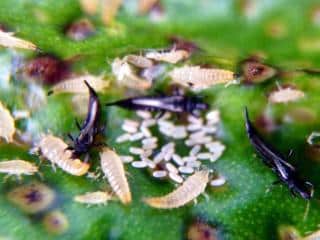
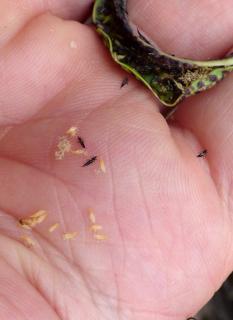
This of course depends on the species of thrips, but the average temperature is a big inflence, too.
Additionally, adult female thrips live for quite a long time, too: usually around a month and a half, or 45 days. During this time, it lays batches of new eggs every few days if the feeding is good.
From egg to adult, only 9 days to 1 month separate one generation from the next.
Eggs, once lain, incubate for 2 to 16 days. They hatch into the first nymph.
Together, all stages from nymph to adult require at least 7 days and at most 15.
For farmers and crops, devastation can be significant.
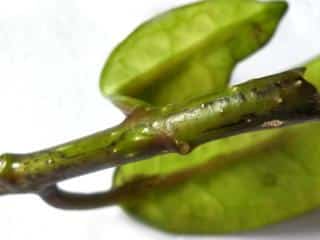
In the picture, you can see white dots on the stem of a Stephanotis vine. These are the laying spots for thrips.
Some thrips lay eggs on the surface of the plant, mostly those of the Tubulifera sub-order.
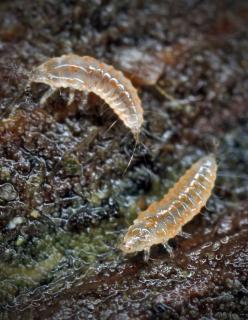
For thrips, these stages include both nymph stages and pupa stages.
Thrips feed and grow during the nymph stages. They travel from one feeding site to another, usually on the same plant.
As they go around, nymphs also excrete waste. These tiny black pebbles look like dots strewn across the leaf. Sometimes these contain compounds that try to repel predator insects.

During these stages, the insect usually stops feeding.
Just like a caterpillar pupates in a cocoon to turn into a butterfly, the thrips nymph evolves into a full adult during the pupa phase.
Thrips will often travel to the ground to pupate. They hide in leaf debris, soil, and mulch. In fall, this is how most thrips prepare for winter.
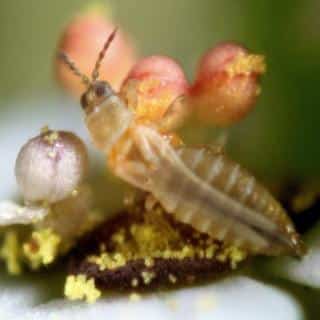
Through pheromones, females attract males. After mating the female starts laying eggs.
Often, tiny wings help the thrips get airborn. Thrips aren’t good flyers, but they’re so small that wind easily carries them away to other plants.
Temperature plays a large part in how fast a thrips will develop. A change from 55°F to 75°F (13 to 23°C) will speed development by 30%! In warm weather, monitor your plants often to catch and control thrips early on!
Very informative article, I’m using “Plant Therapy” to eradicate and seems to be working well, it helps to know there gestation. Period. Thank you.
Great that the article was of help to you. What particular “Plant Therapy” are using to treat against them?
Thank you for the detailed and we’ll written article. I’ve been reading up a lot on thrips lately, and this one was the most detailed, organized, and easy to understand article I’ve encountered so far.
Do the eggs laid inside the plant also have extra protection thanks to it’s shell? I’m wondering if the usual alcohol spray into these plant wounds would be enough to kill off the eggs.
Thanks for the “thumbs up”!
The egg shells help protect the developing thrips inside from the plant’s immune system. It’ll also protect them against alcohol sprayed on them to some degree, but some will still die off.
What is the best systemic insecticide to use on these very hard to control insects?
Hi Ronald, I’d be hard pressed to answer you since I’m not very familiar with insecticides of the chemical kind – especially systemic insecticides that travel in and around the plant. Usually for small populations a few runs of the hose or the vacuum are enough to control them. For larger infestations, it’s more relevant to work with beneficial insects. There are actually some thrips species that eat the pest-type thrips!